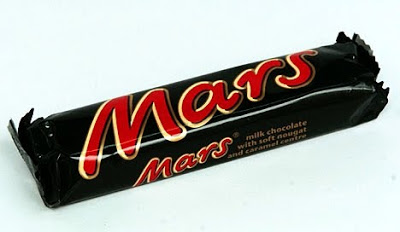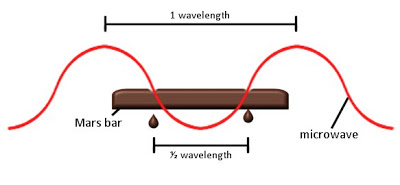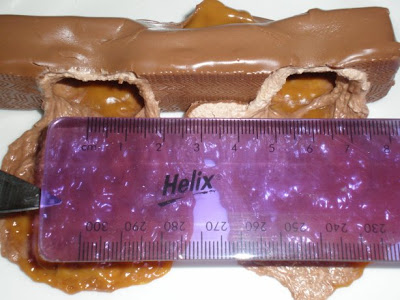Philosophy

A left over chocolate bar from Valentine's Day may be used to measure the speed of light.
Einstein realised that the speed of light was one of the defining measures of the Universe. Remember E=mc2, the beautiful little formula that wrapped up the theory of relativity? Well ‘c’ is the speed of light. And you can measure it. All you need is a microwave, a ruler and a bar of chocolate (and maybe a calculator).
What to do
1.) Remove the revolving tray from your microwave.
2.) On a plate, heat a chocolate bar on full power until it starts to melt in two or three places – this will probably only take about 20 seconds.
3.) Remove the chocolate from the microwave and measure the distance between the melted spots.
4.) Assume your microwave is a standard one which has a frequency of 2.45 gigahertz (you could check this in the back of the manual if you know where it is).
5.) Multiply the distance between the spots on the chocolate bar by 2 and then by 2,450,000,000 (which 2.45 gigahertz expressed as hertz).
6.) Fall off your chair as your result is astoundingly close to 299,792,458, metres per second - the speed of light. (Remember that if you’ve measured the distance in cm then you’ll have to divide your answer by 100).
What happens
 Measuring the distance between the two melted spots means we can work out the wavelength of the microwaves. And if we know the wavelength and the wave frequency, we can work out the speed at which the waves are travelling.
Measuring the distance between the two melted spots means we can work out the wavelength of the microwaves. And if we know the wavelength and the wave frequency, we can work out the speed at which the waves are travelling.
Working out the wavelength
Because the chocolate bar stays still in the microwave, the waves keep hitting it in the same places - the bits which get hot and melt. The distance between the melted spots is the distance of half a wavelength since the microwave passes through the bar both on its way up and way down. Multiplying the distance by two gives us the entire length of one wave.
Why the frequency is important
Microwaves, like light waves, are a form of electromagnetic radiation which travel at light speed. In your oven they have a frequency of 2.45 gigahertz, which means that they bounce up and down 2.45 billion times every second. We have already worked out the wavelength - distance a wave travels when it goes through one up and down cycle - therefore we can work out how far the wave would go in 2.45 billion cycles or, in other words, how far it would go in a second.
Calculating the speed of light
If you found that the distance between the spots was 6cm then 6 x 2 x 2,450,000,000 (2.45 billion) would give you a result of 29,400,000,000 cm per second, or 294,000,000 metres per second – a result which is blinking similar to the real speed of light that physicists spent the best part of half a century trying to measure.

Incidentally, the cooking power of microwaves was first discovered when a scientist stood too close to a microwave experiment with a chocolate bar in his pocket. It melted, the scientist was intrigued and the microwave oven was born.
- Neutrinos And The Speed Of Light
Last week saw two phenomena that seem to challenge a central postulate of the theory of relativity. First, researchers at CERN reported that a stream of neutrinos was determined to have traveled faster than the speed of light. Following that announcement,...
- The Twin Paradox
If you're riding a train and you shoot a gun in the same direction, the total speed of the bullet, relative to the ground, would be the speed of the bullet relative to the gun plus the speed of the train relative to the ground. There's nothing...
- Thus Spake New Horizons
"The Sounds of New Horizons" October 21st, 2013 NASA What does New Horizons say when it calls home? Nothing, without the help of software that transforms zeros and ones from New Horizons’ computers into images, instrument readings, or useful information...
- Should Have Used Heathkit No. 4530949e
There is something to be said about being absolutely sure before a disclosure is announced."Faster-than-light neutrinos could be down to bad wiring"by Jason Palmer February 23rd, 2012BBC NewsWhat might have been the biggest physics story of the past century...
- Howaito Dē...valentine's Day Extension--japanese Style
Of course Valentine's Day is celebrated today [February 14th] and the Japanese celebrate too but the giver is reversed where the females present chocolate gifts. And on March 14th the role is reversed on a day called "White Day" where the men distribute...
Philosophy
Chocolate physics experiment

A left over chocolate bar from Valentine's Day may be used to measure the speed of light.
"Mid Morning Experiment: Speed of Light"
by
Mark Steer
Null Hypothesis: TheJournal of Unlikely Science
by
Mark Steer
Null Hypothesis: TheJournal of Unlikely Science
Einstein realised that the speed of light was one of the defining measures of the Universe. Remember E=mc2, the beautiful little formula that wrapped up the theory of relativity? Well ‘c’ is the speed of light. And you can measure it. All you need is a microwave, a ruler and a bar of chocolate (and maybe a calculator).
What to do
1.) Remove the revolving tray from your microwave.
2.) On a plate, heat a chocolate bar on full power until it starts to melt in two or three places – this will probably only take about 20 seconds.
3.) Remove the chocolate from the microwave and measure the distance between the melted spots.
4.) Assume your microwave is a standard one which has a frequency of 2.45 gigahertz (you could check this in the back of the manual if you know where it is).
5.) Multiply the distance between the spots on the chocolate bar by 2 and then by 2,450,000,000 (which 2.45 gigahertz expressed as hertz).
6.) Fall off your chair as your result is astoundingly close to 299,792,458, metres per second - the speed of light. (Remember that if you’ve measured the distance in cm then you’ll have to divide your answer by 100).
What happens
 Measuring the distance between the two melted spots means we can work out the wavelength of the microwaves. And if we know the wavelength and the wave frequency, we can work out the speed at which the waves are travelling.
Measuring the distance between the two melted spots means we can work out the wavelength of the microwaves. And if we know the wavelength and the wave frequency, we can work out the speed at which the waves are travelling.Working out the wavelength
Because the chocolate bar stays still in the microwave, the waves keep hitting it in the same places - the bits which get hot and melt. The distance between the melted spots is the distance of half a wavelength since the microwave passes through the bar both on its way up and way down. Multiplying the distance by two gives us the entire length of one wave.
Why the frequency is important
Microwaves, like light waves, are a form of electromagnetic radiation which travel at light speed. In your oven they have a frequency of 2.45 gigahertz, which means that they bounce up and down 2.45 billion times every second. We have already worked out the wavelength - distance a wave travels when it goes through one up and down cycle - therefore we can work out how far the wave would go in 2.45 billion cycles or, in other words, how far it would go in a second.
Calculating the speed of light
If you found that the distance between the spots was 6cm then 6 x 2 x 2,450,000,000 (2.45 billion) would give you a result of 29,400,000,000 cm per second, or 294,000,000 metres per second – a result which is blinking similar to the real speed of light that physicists spent the best part of half a century trying to measure.

Incidentally, the cooking power of microwaves was first discovered when a scientist stood too close to a microwave experiment with a chocolate bar in his pocket. It melted, the scientist was intrigued and the microwave oven was born.
- Neutrinos And The Speed Of Light
Last week saw two phenomena that seem to challenge a central postulate of the theory of relativity. First, researchers at CERN reported that a stream of neutrinos was determined to have traveled faster than the speed of light. Following that announcement,...
- The Twin Paradox
If you're riding a train and you shoot a gun in the same direction, the total speed of the bullet, relative to the ground, would be the speed of the bullet relative to the gun plus the speed of the train relative to the ground. There's nothing...
- Thus Spake New Horizons
"The Sounds of New Horizons" October 21st, 2013 NASA What does New Horizons say when it calls home? Nothing, without the help of software that transforms zeros and ones from New Horizons’ computers into images, instrument readings, or useful information...
- Should Have Used Heathkit No. 4530949e
There is something to be said about being absolutely sure before a disclosure is announced."Faster-than-light neutrinos could be down to bad wiring"by Jason Palmer February 23rd, 2012BBC NewsWhat might have been the biggest physics story of the past century...
- Howaito Dē...valentine's Day Extension--japanese Style
Of course Valentine's Day is celebrated today [February 14th] and the Japanese celebrate too but the giver is reversed where the females present chocolate gifts. And on March 14th the role is reversed on a day called "White Day" where the men distribute...
